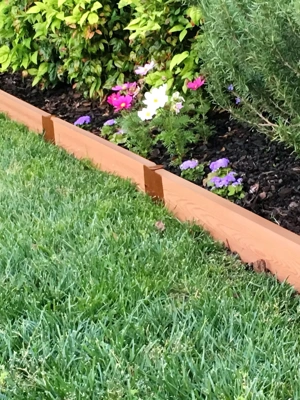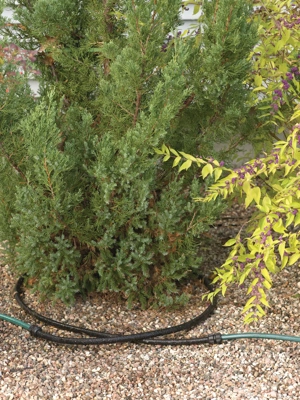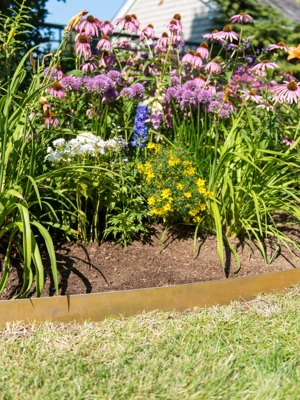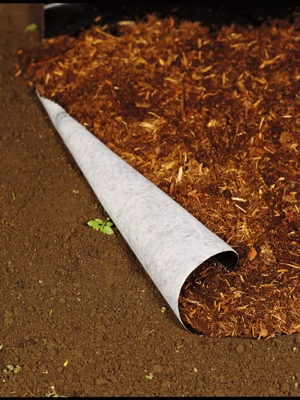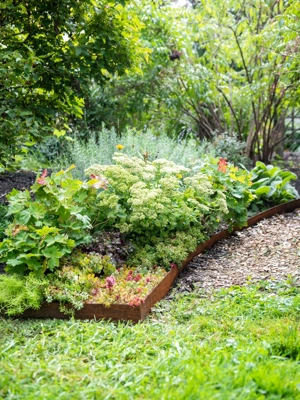Garden Design Techniques that will Transform Your Landscape
 Red helenium, blue globe thistle, and rudbeckia bloom in a palette of primary colors at the Coastal Maine Botanical Garden. All photos by Kerry Ann Mendez except where noted.
Red helenium, blue globe thistle, and rudbeckia bloom in a palette of primary colors at the Coastal Maine Botanical Garden. All photos by Kerry Ann Mendez except where noted.In This Article
Some design techniques can result in monumental visual improvements. The problem-solving and beautification recommendations listed below will transform gardens without increasing maintenance time. These work equally well for large and small gardens.
Get to the Point, Please: Focal Points in the Garden
A focal point draws and directs the eye. Not only does a captivating piece enhance a garden's beauty, it also engages and provides a resting point for the eye, slowing the pace for completing a garden's visual enjoyment. Rather than wolfing down the gourmet experience in one swift "bite," a focal point stretches out the pleasurable experience. A focal point is especially essential in small gardens to immediately capture the visitors' interest.
 Planters with obelisks do triple-duty: They act as focal points, they mark the entrance to a path, and when strung with lights, they add evening enchantment year-round. Enchanted Woods Pot Obelisk and Battery-Operated Fairy Lights. Photo: Gardener's Supply Company.
Planters with obelisks do triple-duty: They act as focal points, they mark the entrance to a path, and when strung with lights, they add evening enchantment year-round. Enchanted Woods Pot Obelisk and Battery-Operated Fairy Lights. Photo: Gardener's Supply Company.Options for focal points are as boundless as one's imagination:
- A boulder adorned with lichen or moss
- A fascinating sculpture
- An eye-catching specimen plant
- A bubbling container water fountain
- Old work boots filled with succulents
When siting the piece de resistance, don't center it in the garden. Place it just off center. Large gardens can support multiple focal points. For smaller gardens, one well-selected and placed showpiece is sufficient.
 Look closely and you'll see the mirror in back, doubling the effect of this planting at the Frederik Meijer Gardens and Sculpture Park in Grand Rapids, Michigan.
Look closely and you'll see the mirror in back, doubling the effect of this planting at the Frederik Meijer Gardens and Sculpture Park in Grand Rapids, Michigan.Mirror, Mirror, on the Wall: Create the Illusion of a Bigger Garden
Mirrors work magic in small areas, creating the illusion of a larger garden room. By tactfully placing a mirror to reflect a gorgeous garden or container collection, one can enjoy the display from two different locations, without twice the maintenance.
Or perhaps you have a striking focal point that would also look great "framed" in the mirror. Another idea is siting a mirror so it reflects sunlight into a shady garden nook, allowing for plants that require more sun to thrive. Use your imagination!
 Sedum, with its large, fleshy leaves and domed flower heads, contrasts beautifully with wispy molinia grass.
Sedum, with its large, fleshy leaves and domed flower heads, contrasts beautifully with wispy molinia grass.Opposites Attract: Using Contrast to Draw Attention
If you want to increase, extend, and intensify color in your garden, think foliage. Leaves are present before, during, and after bloom. Foliage is the easiest way to insert color month after month (perhaps second only to non-living objects), with little labor on your part. Breathtaking displays can be created by combining leaves of various colors and patterns, shapes, sizes, and textures. Some of the most extraordinary gardens I've seen are those with few or no flowers (although these are not beneficial to pollinators).
Pairing large, bold-leaved plants with finer, delicate specimens is particularly striking. I like to think of this combo as 'Beauty and the Beast'. Partnering perennials rodgersia 'Bronze Peacock' (zones 5-8), with its massive, highly textured, bronze leaves and hakonechloa 'All Gold' (zones 5-9), sporting narrow, shiny golden blades, makes a fascinating display in shade. A sunny counterpart would be Rudbeckia maxima (zones 4-9), threadleaf coreopsis 'Zagreb' (zones 4-9) and little bluestem (Schizachyrium scoparium) (zones 3-9), all native to North America.
 Bold ornamental rhubarb at the Coastal Maine Botanical Garden
Bold ornamental rhubarb at the Coastal Maine Botanical GardenHulk-leaved perennials include umbrella plant (Darmera peltata, zones 5-7), ornamental rhubarb (Rheum palmatum, zones 3-9), ligularia 'King Kong' (and many others in this genus, zones 4-9), Astilboides tabularis (zones 5–7), and giant hosta, such as 'Big Daddy' and 'Sum and Substance' (zones 3-9). Lacy, airy choices are fringed bleeding heart (Dicentra eximia, zones 3-9), Arkansas blue star (Amsonia hubrechtii, zones 4-9), Mexican feathergrass (Nassella tenuissima, zones 6/7-9), and Vernonia lettermanii 'Southern Cross' (Zones 4–9).
 Note how the repetition of terra cotta color in textiles and flowers brings unity to this colorful and inviting display at the Hampton Court Flower Show. Photo: Susan Romanoff
Note how the repetition of terra cotta color in textiles and flowers brings unity to this colorful and inviting display at the Hampton Court Flower Show. Photo: Susan RomanoffBring It All Together Now: Creating Unity with Repetition
Repetition is a commonly used design technique to impart flow and consistency in a garden bed. A particular plant or color is the unifying element. This approach has even greater impact when used to unite an entire landscape. Picture all the gardens linking arms with containers, window boxes, hanging baskets, and other outdoor accessories.
The easiest way to accomplish this subtle merger is by repeating a selected color (shades or tints). This color can be echoed in inanimate objects such as containers, outdoor furniture, focal points, pillows and cushions, birdbaths, and more. As far as plants carrying this "color baton," foliage is the simplest means to accomplish this, providing three, if not four, seasons of harmony. Remember to also include unifying foliage plants in containers and other vessels.
Some Like it Hot; Some Like it Cold: Color Sets the Mood
Color is a powerful garden design tool. Hot colors (red, yellow, orange, fuchsia) grab our attention quickly. These brilliant colors excite and appear closer than they actually are. Cool colors (blue, green, purple, violet, and pastels) instill a sense of calm and seem farther away. Cool colors are also difficult to see from a distance and in shade. Plants with silver-hued foliage are terrific buffers and peacemakers between clashing colors.

 Compare the hot color palette at the top to the cool hues below and the different moods they evoke. Photos of the entryway gardens at the Rotary Botanical Gardens are courtesy Mark Dwyer.
Compare the hot color palette at the top to the cool hues below and the different moods they evoke. Photos of the entryway gardens at the Rotary Botanical Gardens are courtesy Mark Dwyer.
Using Color to Direct the Eye
You can use some of these impressions to your advantage. For instance, you can direct the eye towards a focal point by planting hot colors near it, while you can also guide the eye away from an eyesore by placing these same hot colors at a distance from it. Gardens appear closer than they actually are when bright colors dominate the bed; or conversely, seem to recede and look farther away when cool colors are featured.
 Brilliant blooms in the Children's Garden at the Coastal Maine Botanical Garden.
Brilliant blooms in the Children's Garden at the Coastal Maine Botanical Garden.As noted, colors can trigger emotions. My twin sister loves her garden jammed with hot colors: masses of orange, fuchsia, and red flowers. After gazing at her beds I feel like I've had five cups of coffee! My younger sister is also partial to sizzling colors. She planted a garden in full sun (that also has a lot of reflected heat from boulders) using only brilliant yellow, red, and orange blooms. This fiery plant palate, combined with the garden's setting, had me begging for a drink! My garden, on the other hand, is composed of mostly cool colors — lavender, purple, blue, soft pink, pale yellow, and silver. I use hot colors as carefully placed "exclamation marks." Having said all of the above, there is no right or wrong when using colors in your garden. Beauty is in the eye of the beholder — yours!
Last updated: 11/30/2022
Print this Article:
Related items
Get the Dirt
Stay up to date on new articles and advice. Please fill out the information below.

